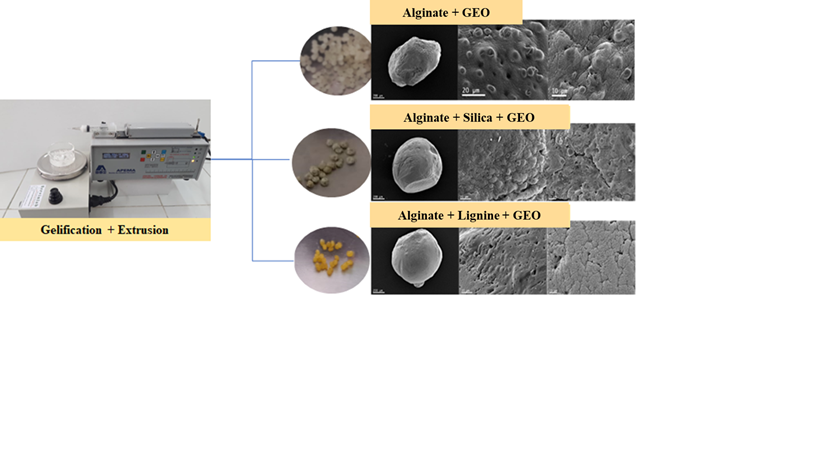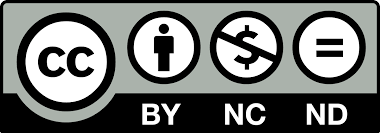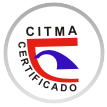MICROENCAPSULACIÓN DE ACEITE ESENCIAL DE POMELO EN MATRICES DE ALGINATO-LIGNINA Y ALGINATO-SÍLICE Y MODELADO DE SU LIBERACIÓN CONTROLADA
Palabras clave:
encapsulación; alginato; lignina; sílica; aceites esencialesResumen
Translator
La metodología de encapsulación protege los aceites esenciales de factores externos (aire, luz, humedad y altas temperaturas), limita su degradación y permite su lenta liberación. Este estudio tuvo como objetivo optimizar la encapsulación por gelificación iónica de aceite esencial de pomelo en matriz de alginato de sodio, obteniendo un rendimiento superior al 50 %, y teniendo una eficiencia superior al 90 %. Se estudiaron dos nuevas matrices que combinan alginato de sodio con lignina y sílice. Estos componentes se obtuvieron a partir de biomasa de cascarilla de arroz y mostraron una eficiencia del 99,91 %, un rendimiento del 67,18 % al tener una concentración de lignina del 1 % y una tasa de eficiencia del 97,67 %, y un rendimiento del 52,31% con 0,8 % de sílice. Además, se utilizó secado al vacío reduciendo el tamaño y la humedad de las microcápsulas. Los perfiles de liberación controlada considerados en cada caso se ajustaron al modelo de Peppas y Korsmeyer para sistemas poliméricos.
Citas
TABAN, A.; SAHARKHIZ, M. J.;
HOOSHMANDI, M. “Insecticidal and repellent
activity of three Satureja species against adult red
flour beetles, Tribolium castaneum (Coleoptera:
Tenebrionidae)” En línea. Acta Ecologica Sinica.
, 37(3), 201-206.
http://dx.doi.org/10.1016/j.chnaes.2017.01.001
RIOS MERA, J. D. et al. “Encapsulation
optimization and pH- and temperature-stability of the
complex coacervation between soy protein isolate and
inulin entrapping fish oil”. LWT. 2019, 116, 108555.
https://doi.org/10.1016/j.lwt.2019.108555
CHE, N.; DEMPERE, L. A.; TONG, Z. “Synthesis
of pH-Responsive Lignin-Based Nanocapsules for
Controlled Release of Hydrophobic Molecules”. ACS
Sustainable Chemistry & Engineering. 2016, 4(10),
-5211.
https://doi.org/10.1021/acssuschemeng.6b01209
LEAL MAZZA, K. et al. “Microencapsulation of
marjoram essential oil as a food additive using sodium alginate and whey protein isolate”. International
Journal of Biological Macromolecules. 2023, 123478.
https://doi.org/10.1016/j.ijbiomac.2023.123478
BENAVIDES, S.; CORTÉS, P.; PARADA, J.;
FRANCO, W. “Development of alginate
microspheres containing thyme essential oil using
ionic gelation”. Food chemistry. 2016, 204, 77-83.
http://dx.doi.org/10.1016/j.foodchem.2016.02.104
ARRIOLA, N. D. et al. “Encapsulation of stevia
rebaudiana Bertoni aqueous crude extracts by ionic
gelation - Effects of alginate blends and gelling
solutions on the polyphenolic profile”. Food
Chemistry. 2019, 275, 123-134.
https://doi.org/10.1016/j.foodchem.2018.09.086
DA SILVA C., A. G. et al. “Anthocyanins from
jussara (Euterpe edulis Martius) extract carried by
calcium alginate beads pre-prepared using ionic
gelation”. Powder Technology. 2019, 345, 283-291.
https://doi.org/10.1016/j.powtec.2019.01.016
POPESCU, L. et al. “The Effect of Aromatic Plant
Extracts Encapsulated in Alginate on the Bioactivity,
Textural Characteristics and Shelf Life of Yogurt”.
Antioxidants. 2023, 12(4), 893.
https://doi.org/10.3390/antiox12040893
ATENCIO, S.; MAESTRO, A.; SANTAMARIA,
E.; GUTIÉRREZ, J. M.; GONZÁLEZ, C.
“Encapsulation of ginger oil in alginate-based shell
materials”. Food Bioscience. 2020, 37, 100714.
https://doi.org/10.1016/j.fbio.2020.100714
BELSCAK CVITANOVIC, A. et al. “Emulsion
templated microencapsulation of dandelion
(Taraxacum officinale L.) polyphenols and β-carotene
by ionotropic gelation of alginate and pectin”. Food
hydrocolloids. 2016, 57, 139.
http://dx.doi.org/10.1016/j.foodhyd.2016.01.020
SAIFULLAH, M.; SHISHIR, M. R. I.;
FERDOWSI, R.; RAHMAN, M. R. T.; VAN
VUONG, Q. “Micro and nanoencapsulation, retention
and controlled release of flavor and aroma
compounds: A critical review”. Trends in Food
Science & Technology. 2019, 86, 230-251.
https://doi.org/10.1016/j.tifs.2019.02.030
CHAN, E. S. “Preparation of Ca-alginate beads
containing high oil content: Influence of process
variables on encapsulation efficiency and bead
properties”. Carbohydrate Polymers. 2011, 84(4),
-1275.
https://doi.org/10.1016/j.carbpol.2011.01.015
LI, M.; JIANG, X.; WANG, D.; XU, Z.; YANG,
M. “In situ reduction of silver nanoparticles in the
lignin-based hydrogel for enhanced antibacterial
application”. Colloids and Surfaces B: Biointerfaces.
, 177, 370-376.
https://doi.org/10.1016/j.colsurfb.2019.02.029
HAN, X.; LIANG, J.; FUKUDA, S.; ZHU, L.;
WANG, S. “Sodium alginate-silica composite
aerogels from rice husk ash for efficient absorption of
organic pollutants. Biomass and Bioenergy” Biomass
and Bioenergy. 2022, 159, 106424.
https://doi.org/10.1016/j.biombioe.2022.106424
VASEK, O. M.; CÁCERES, L. M.;
CHAMORRO, E.; VELASCO, G. A. “Antibacterial
activity of Citrus paradisi essential oil”. Journal of
Natural Products. 2015, 8, 16-26.
http://hdl.handle.net/20.500.12272/941
CÁCERES, L. M.; VELASCO, G. A.;
DAGNINO, E. P.; CHAMORRO, E. R.
“Microencapsulación de Aceite de Pomelo con
Alginato de Sodio por Gelificación y Extrusión
Iónica: Optimización y Modelado de la Reticulación y
Estudio de la Cinética de Liberación Controlada”.
Revista Tecnología y Ciencia. 2020, 39, 41-61.
https://doi.org/10.33414/rtyc.39.41-61.2020
DAGNINO, E. P.; CHAMORRO, E. R.;
ROMANO, S. D.; FELISSIA, F. E.; AREA, M. C.
“Optimization of the acid pretreatment of rice hulls to
obtain fermentable sugars for bioethanol production”.
Industrial Crops and Products. 2013, 42, 363.
https://doi.org/10.1016/j.indcrop.2012.06.019
LEVIĆ, S. et al. “Characterization of sodium
alginate/d-limonene emulsions and respective calcium
alginate/d-limonene beads produced by electrostatic
extrusion”. Food Hydrocolloids. 2015, 45, 111-123.
https://doi.org/10.1016/j.foodhyd.2014.10.001
MONTGOMERY, D. C. Diseño y análisis de
experimentos. 2a Edición. México: Limusa Wiley,
686 p. ISBN: 9681861566.
MAJI, T. K.; BARUAH, I.; DUBE, S.;
HUSSAIN, M. R. “Microencapsulation of
Zanthoxylum limonella oil (ZLO) in glutaraldehyde
crosslinked gelatin for mosquito repellent
application”. Bioresource Technology. 2007, 98(4),
-844.
https://doi.org/10.1016/j.biortech.2006.03.005
TANG, S. et al. “Construction of physically
crosslinked chitosan/sodium alginate/calcium ion
double-network hydrogel and its application to heavy
metal ions removal”. Chemical Engineering Journal.
, 393, 124728,
https://doi.org/10.1016/j.cej.2020.124728
DERDAR, H.; BELBACHIR, M.; HARRANE, A.
“A Green Synthesis of Polylimonene Using
Maghnite-H+, an Exchanged Montmorillonite Clay,
as Eco-Catalyst”. Bulletin of Chemical Reactions Engineering & Catalysis. 2019, 14(1), 69-78.
https://doi.org/10.9767/bcrec.14.1.2692.69-78
VAN HOOGMOED, C. G.; BUSSCHER, H. J.;
DE VOS, P. “Fourier transform infrared spectroscopy
studies of alginate-PLL capsules with varying
compositions”. Journal of Biomedical Materials
Research A. 2003, 67(1),172-178.
https://doi.org/10.1002/jbm.a.10086
UM, H.; KANG, R. H.; KIM, D. “Iron-silicatecoated porous silicon nanoparticles for in situ ROS
self-generation”. Colloids and Surfaces B:
Biointerfaces . 2023, 225 113273.
https://doi.org/10.1016/j.colsurfb.2023.113273
CAREY, F. A. Química Orgánica. 6ª
Edición. México: McGraw-Hill Interamericana, 2014.
p. ISBN: 970-10-5610-8
ONAIZI, S. A. et al. “Crude oil/water
nanoemulsions stabilized by biosurfactant: Stability
and pH-Switchability”. Journal of Petroleum Science
and Engineering. 2021, 198, 108173.
https://doi.org/10.1016/j.petrol.2020.108173
BANERJEE, S. et al. “Influence of process
variables on essential oil microcapsule properties by
carbohydrate polymer-protein blends”. Carbohydrate
Polymers. 2013, 93(2), 691-697.
https://doi.org/10.1016/j.carbpol.2013.01.028
NOPPAKUNDILOGRAT, S.; PIBOON, P.;
GRAISUWAN, W.; NUISIN, R.;
KIATKAMJORNWONG, S. “Encapsulated
eucalyptus oil in ionically cross-linked alginate
microcapsules and its controlled release”.
Carbohydrate Polymers. 2015, 131, 23-33.
https://doi.org/10.1016/j.carbpol.2015.05.054
SOLIMAN, E. A.; EL MOGHAZY, A. Y.;
MOHY EL-DIN, M. S.; MASSOUD, M. A.
“Microencapsulation of Essential Oils within
Alginate: Formulation and in vitro Evaluation of
Antifungal Activity”. Journal of Encapsulation and
Adsorption Sciences. 2013, 3(01), 48-55.
http://dx.doi.org/10.4236/jeas.2013.31006
SHAMSUDIN, M. S. et al. “Performance and
interactions of diclofenac adsorption using
Alginate/Carbon-based Films: Experimental
investigation and statistical physics modelling”.
Chemical Engineering Journal. 2022, 428, 131929.
https://doi.org/10.1016/j.cej.2021.131929
FARRÉS, I. F.; NORTON, I. T. “Formation
kinetics and rheology of alginate fluid gels produced
by in situ calcium release”. Food Hydrocolloids.
, 40, 76-84.
http://dx.doi.org/10.1016/j.foodhyd.2014.02.005
ASHRAF, M. A.; KHAN, A. M.; AHMAD,
M.; SARFRAZ, M. “Effectiveness of silica based
sol-gel microencapsulation method for odorants
and flavors leading to sustainable environment”.
Frontiers in Chemistry. 2015, 3, 42.
https://doi.org/10.3389/fchem.2015.00042
MARTIN, M. J.; LARA VILLOSLADA, F.;
RUIZ, M. A.; MORALES, M. E. “Effect of
unmodified starch on viability of alginateencapsulated Lactobacillus fermentum
CECT5716”. LWT - Food Science and Technology.
, 53(2), 480-486.
https://doi.org/10.1016/j.lwt.2013.03.019
SHIM, J.; LIM, J. M.; SHEA, P. J.; OH, B. T.
“Simultaneous removal of phenol, Cu and Cd from
water with corn cob silica-alginate beads”. Journal
of Hazardous Materials. 2014, 2, 129-136.
https://doi.org/10.1016/j.jhazmat.2014.03.010
SIEPMANN, J.; FAISANT, N.; BENOIT, J. P.
“A New Mathematical Model Quantifying Drug
Release from Bioerodible Microparticles Using
Monte Carlo Simulations”. Pharmaceutical
Research. 2002, 19(12), 1885-1893. ISSN: 1573-
X. https://doi.org/10.1023/A:1021457911533
LOCALI PEREIRA, A. R.; LOPES, N. A.;
MENIS HENRIQUE, M. E. C.; JANZANTTI, N.
S.; NICOLETTI, V. R. “Modulation of volatile
release and antimicrobial properties of pink pepper
essential oil by microencapsulation in single- and
double-layer structured matrices”. International
Journal of Food Microbiology. 2020, 335, 108890.
https://doi.org/10.1016/j.ijfoodmicro.2020.108890
LAI, H. et al. “Fabrication and antibacterial
evaluation of peppermint oil-loaded composite
microcapsules by chitosan-decorated silica
nanoparticles stabilized Pickering emulsion
templating”. International Journal of Biological
Macromolecules. 2021, 183, 2314.
https://doi.org/10.1016/j.ijbiomac.2021.05.198
FERNÁNDEZ, J. A.; SANTOS, R. G.;
ESTÉVEZ, G. F. “Cinética de liberación de
cefalexiana desde un biomaterial compuesto por
HAP-200/POVIAC/CaCO3”. Anales de la Real
Academia Nacional de Farmacia. 2009, 75(3).
https://core.ac.uk/download/pdf/230310909.pdf
PAPADOPOULOU, V.; KOSMIDIS, K.;
VLACHOU, M.; MACHERAS, P. “On the use of
the Weibull function for the discernment of drug
release mechanisms”. International Journal of
Pharmaceutics, 2006. 309(1-2), 44-50.

Descargas
Publicado
Cómo citar
Número
Sección
Licencia
Derechos de autor 2025 Liliana Mariel-Cáceres , Eliana Paola Dagnino, Ester Chamorro

Esta obra está bajo una licencia internacional Creative Commons Atribución-NoComercial-SinDerivadas 4.0.
Esta revista proporciona un acceso abierto inmediato a su contenido, basado en el principio de que ofrecer al público un acceso libre a las investigaciones ayuda a un mayor intercambio global de conocimiento. Cada autor es responsable del contenido de cada uno de sus artículos.






















